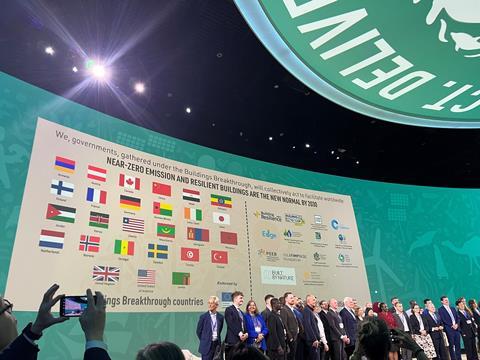COP has turned into a gigantic and unwieldy gathering that is failing to identify the actual mechanisms for achieving its 2030 targets, writes Sumita Singha

I visited the annual United Nations Climate Change Conference COP (Conference Of the Parties) for the first time in Dubai. While the one in the Hague held in 2000 could fit into one auditorium, this year there were about 80,000 people present for the ‘Blue zone’ alone and apparently, 400,000 passes for the ‘Green zone’ for the general public.
RIBA has been granted ‘observer status’ since the one held in Glasgow in 2021 and I wanted to see how architects could engage with the challenge of the climate crisis, given that buildings are responsible for 40% emissions.
So it was rather disconcerting to find that my entire journey from the hotel to the vast Dubai Expo, about 20 miles away, using the Dubai metro, took place in an air-conditioned environment. Given the numbers of people, heavy security due to the world leaders gathered there on the first two days and general confusion, airport style entry took about an hour each day.
Then once inside, it was a 30-40 minute walk to find the actual buildings where talks were scheduled (and usually rescheduled). At each step, someone was being interviewed and words like ‘decarbonising’, green finance, sustainability, and net zero could be heard and seen everywhere!
What seemed to be missing was a holistic picture of how to achieve the goals for 2030 in the most effective and efficient way
Big transnational corporations such as those for concrete and cement, Big Oil (OPEC) and big (i.e wealthy) nations took centre stage- not a bad thing considering that they need to change first. But many important conversations were missing, including what the alternative energy sources could be in 2030 (just 6 years away now), how different countries could find different solutions that worked for them and what individuals could do. What exactly did ‘green growth’ look like or how would the carbon from ‘unabated’ fossil fuels be captured?

On the designated built environment day, we heard that there is no universally accepted definition of net zero or sustainable buildings. Also that the entire supply chain in construction needs transformation, not just for energy during construction and operations but for the energy involved in demolition, recycling, and consideration for ethical production.
This is a huge and complex task, given that we use many things that are not produced locally. In fact if you were to look at the room from where you are reading this, 90% of the things around you are likely to have been shipped. Almost 60% of the materials taken from the planet and used for construction since 2017 have been mined somewhere, manufactured somewhere else and then transported to the end user.
Then there is the consumer carbon – that the carbon used for the production should be counted in the country of use, rather than country of production. Some statistics use the carbon production of countries since the Industrial Revolution while some use per capita carbon consumption as a better indicator of who should be limiting theirs. There is also the nebulous world of ‘scope 3 emissions’ which consist of the emissions from the services provided by third party suppliers such as travel, goods and waste processing.
The loss and damage payment to countries agreed on the first day, is a watered down version of the climate reparations owed since the Paris Agreement in 2015 (COP21) and there won’t be enough to cover the numbers of countries affected or the scale of damage. The final agreement to ‘phase out’ fossil fuels is not binding and if the technology for any climate mitigation work is not freely available, how can the poor countries cope? What seemed to be missing was a holistic picture of how to achieve the goals for 2030 in the most effective and efficient way.
I think these conferences could be held online, given how little engagement there is with smaller organisations, countries and sectors. That way, at least, most of us could attend most events and have a voice!
>> Also read: Net zero buildings by 2050? You have got to be joking!
>> Also read: Thrive - A Field Guide for Women in Architecture
Postscript
Sumita Singha is an award-winning architect, academic and author.
She founded RIBA’s equality forum, Architects for Change and is a past chair of Women In Architecture. She is currently a trustee of the RIBA Board and Commonwealth Association of Architects. She is the author of many books, including Architecture For Rapid Change and Scarce Resources, and Thrive: a field guide for women in architecture, RIBA Publishing, 2023.
















No comments yet